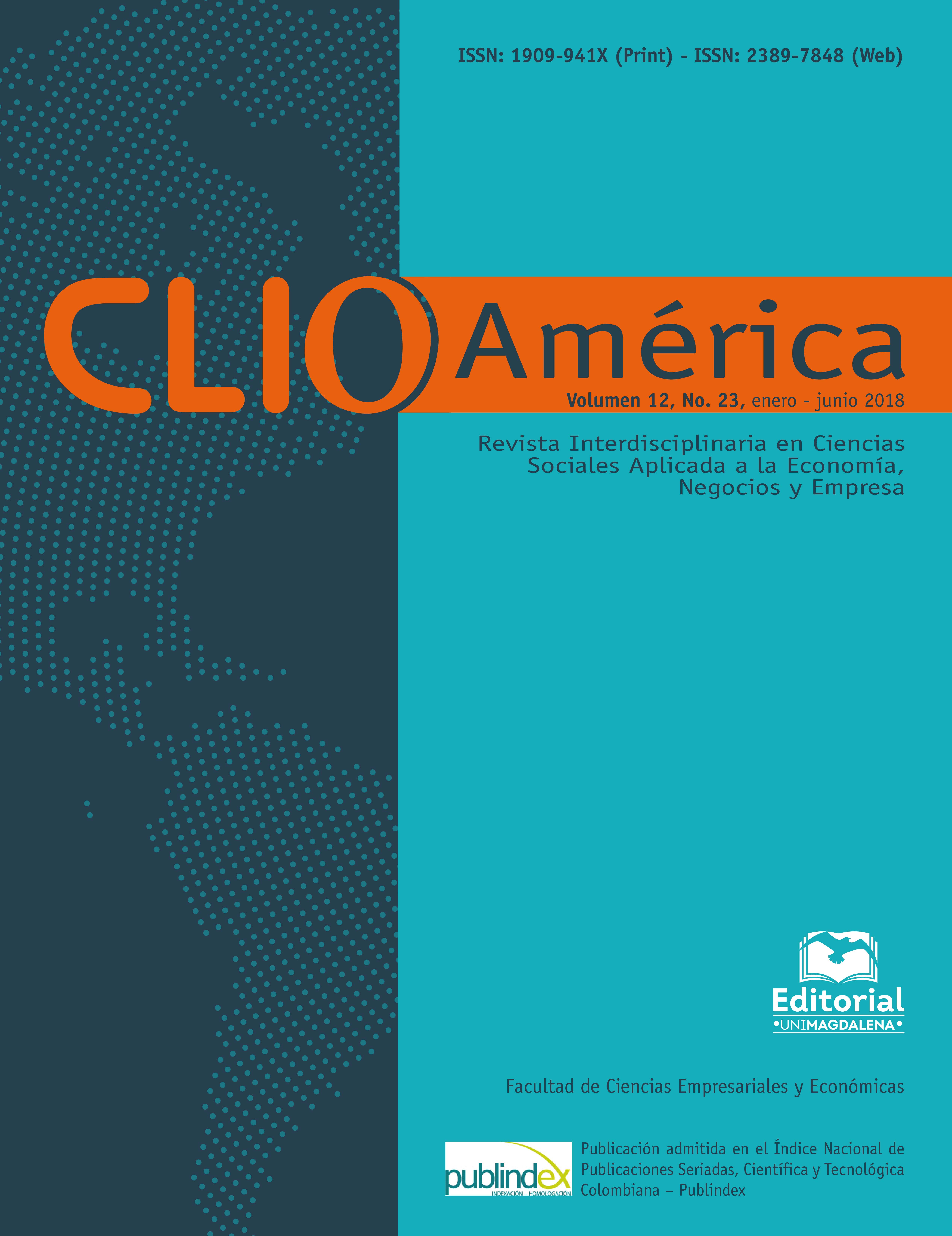Abstract
The objective of this article is to determine the location of an organization's place of operations through the application of a new method that includes the recalculation of coordinates and qualitative factors, which represent restrictions for its location. Therefore, localization methods are essential when facilitating the location of a productive site, such as the center of gravity method, through which it is possible to find the location of the site for a company; however, this method is 100 % quantitative and only takes into account aspects such as demand and location coordinates of the production site. As a conclusion of the exercise, it is evident that the use of the center of gravity method is insufficient; given that the location obtained is not optimal and therefore, it is necessary to apply a new method of relocation, which determines the new site of interest, called in this case the "Mathematical Method of Recalculation of Coordinates - MMRC", by means of factor analysis of a qualitative nature that affect the new location of the site, guaranteeing the most reliable relocation; presenting, in turn, two case studies, which show the feasibility and benefits of the application of this new scientific tool.References
Albornoz, V. y Johns, E. (2011). Localización de Paraderos de Detención y Diseño Optimo de Rutas en el Transporte de Personal, Ingeniare. Revista Chilena de Ingeniería, 19 (3), 457-472. Recuperado de https://scielo.conicyt.cl/scielo.php?script=sci_abstract&pid=S0718-33052011000300014&lng=en&nrm=i.p&tlng=es
Ares, M. F. (2003). Análisis y business plan de una empresa de transporte de mercancías destinada al reparto a grandes superficies y plataformas asociadas (Tesina de Escola Tècnica Superior d'Enginyers de Camins, Canals i Ports de Barcelona – Enginyeria de Camins, Canals i Ports). Universitat Politécnica de Catalunya, Barcelona Tech, España.
Arsanjani, J., Helbich, M., Kainz, W. y Bolooranic, A. D. (2013). Integration of logistic regression, Markov chain and cellular automata models to simulate urban expansion. International Journal of Applied Earth Observation and Geoinformation, 21, 265–275. Recuperado de: http://vbn.aau.dk/en/publications/integration-of-logistic-regression-markov-chain-and-cellular-automata-models-to-simulate-urban-expansion(2dab6b89-2b1d-41b8-9693-a810947e7558).html
Ballou, R. (2004). Logística Administración de la Cadena de Suministro. México: Pearson Educación.
Behera, M., Borate, S., Panda, S., Behera, P. y Roy, P. (2012). Modelling and analyzing the watershed dynamics using cellular automata (CA), Markov model (A), geo-information based approach. Journal of Earth Sciences, 121, 1011–1024. Recuperado de https://www.ias.ac.in/article/fulltext/jess/121/04/1011-1024
Causado-Rodríguez, E. y Reatiga, I. (2013). Cadena logística de subproductos residuales en la industria de tajada de plátano para exportación. Revista Dimensión Empresarial, 11(2), 9-16. Recuperado de http://ojs.uac.edu.co/index.php/dimension-empresarial/article/view/77
Causado-Rodriguez, E., García, J., Martínez, J. y Herrera, A. (2015). Tecnologías de información y comunicación en el sector hotelero. Barranquilla: Ediciones Corporación Universitaria Latinoamericana. Recuperado de http://repositorio.cuc.edu.co/xmlui/bitstream/handle/11323/802/TECNOLOG%C3%ADAS%20DE%20INFORMACI%C3%93N%20Y%20COMUNICACI%C3%93N%20EN%20EL%20SECTOR%20HOTELERO-Libro.pdf?sequence=1&isAllowed=y
Chase, R., Jacobs, F. y Aquilano, N. (2009). Administración de Operaciones Producción y Cadena de Suministro. México: Mc Graw Hill. Recuperado de https://www.u-cursos.cl/usuario/b8c892c6139f1d5b9af125a5c6dff4a6/mi_blog/r/Administracion_de_Operaciones_-_Completo.pdf
Chen, C.T. (2001). A fuzzy approach to select the location of the distribution center. Fuzzy sets and systems. 118(1), 65 – 73. Recuperado de https://ac.els-cdn.com/S016501149800459X/1-s2.0-S016501149800459X-main.pdf?_tid=b833fc92-2f88-423b-aa9c-fcccd1c03400&acdnat=1539018076_0c8424f6b70a49088e3343a4a8e007d6
Demirel, T., Demirel, N. y Cengiz, K. (2010). Multi-criteria warehouse location selectin using Choquet integral. Expert Systems with Applications. 37(5), 3943-3952. doi: https://doi.org/10.1016/j.eswa.2009.11.022
Feldmann, A. y Olhager, J. (2013). Plant roles - site competence bundles and their relationships with site location factors and performance. Int. J. Oper. Prod. Manag. 33, 722-744.
Garrocho, C. (2003). La teoría de interacción espacial como síntesis de las teorías de localización de actividades comerciales y de servicios. Economía, Sociedad y Territorio, IV(14), 203-251. Recuperado de file:///C:/Users/revistaclioamerica/Downloads/426-3911-1-PB.pdf
González, M. (2014). Competencia espacial y estrategias de localización en la Zona Metropolitana de Guadalajara. El caso de los Bancos Walmart y Banco Azteca (Tesis de maestría). Universidad de Guadalajara, México.
Guan, D., Li, H., Inohae, T., Su, W., Nagaie, T. y Hokao, K. (2011). Modeling urban land use change by the integration of cellular automaton and Markov model. Ecological Modelling, 222(20–22), 3761–3772. Recuperado de https://ac.els-cdn.com/S0304380011004698/1-s2.0-S0304380011004698-main.pdf?_tid=526162e3-1cd3-48fe-af26-40b3ab81ba40&acdnat=1539023432_bed5e84d9a0d450eaa0d874ff6082b0b
Heizer, J. y Render, B. (2004). Principios de Administración de Operaciones. Quinta Edición. México, Pearson Educación: Prentice Hall. Recuperado de https://www.academia.edu/15694412/Principios-De-Administraci%C3%B3n-De-Operaciones-7ma-Heizer
Huang, R., Menezes, M. y Kim, S. (2012). The impact of cost uncertainty on the location of a distribution center. European Journal of Operational Research, 218(2), 401-407. Recuperado de https://www.sciencedirect.com/science/article/pii/S0377221711010071
Jafarian, M., Azizolah, J., Mehdi, S.Y. y Seyed Javad, H. (2009). A new multiobjective modeling in distribution center location problem. In 6th International conference on Industrial Engineering, Teherán, Irán. Recuperado de http://works.bepress.com/jafarian/6/.
Laporte, G. (1992). The Vehicle Routing Problems: An overview of exact and approximate algorithms”. European Journal of Operational Research, 59, 345-358. Recuperado de https://pdfs.semanticscholar.org/bd68/0d5708297eb76513611919c1145694db77e4.pdf
Melkote, S. y Daskin, M. (2001). Capacitated Facility Location/Network Design Problems. European Journal of Operational Research, 129(3), 481- 495. Recuperado de: http://citeseerx.ist.psu.edu/viewdoc/download?doi=10.1.1.848.6686&rep=rep1&type=pdf
Organización Mundial del Comercio - OMC. (2016). Informe Sobre El Comercio Mundial 2016 “Igualdad de condiciones para el comercio de las pymes”. Recuperado de https://www.wto.org/spanish/res_s/booksp_s/world_trade_report16_s.pdf
Posada, J. (2011). Aspectos a considerar para una buena gestión en los almacenes de las empresas (Centros de Distribución, Cedis). Journal of Economics, Finance and Administrative Science, 16(30), 83 - 96. Recuperado de http://www.scielo.org.pe/scielo.php?pid=S2077-18862011000100007&script=sci_abstract
Sánchez, J. (2007). Pautas de Localización de las sedes de las Grandes Empresas y Entornos Metropolitanos, Revista Eure, 33(100), 69-90. Recuperado de https://scielo.conicyt.cl/scielo.php?script=sci_arttext&pid=S0250-71612007000300005
Sun, H., Forsythe, W. y Waters, N. (2007). Modeling urban land use change and urban sprawl: Calgary, Alberta, Canada. Networks and Spatial Economics, 7(4), 353–376. Recuperado de https://link.springer.com/article/10.1007/s11067-007-9030-y
Turkesteen, M, y Klose, B. (2012). Demand dispersion and logistics costs in one-to- many distribution Systems. European Journal of Operational Research, 223(2), 499 – 507. Recuperado de https://www.sciencedirect.com/science/article/pii/S0377221712004638
Urango, O., Pérez, G. y Romo, G. (2015). Aplicación de las técnicas de gravedad y AHP para la localización de un centro de distribución de productos industriales en Colombia. Revista CEA, 1(2), 79-97. Recuperado de https://revistas.itm.edu.co/index.php/revista-cea/article/view/132
Weber, A. (1922). Uber den Standort der Industrien. Erster Teil Reine Theorie des Standorts, Germany: Tubingen. Recuperado de https://archive.org/details/ueberdenstandort00webeuoft
This journal provides an open access to its content, based on the principle of offering the public free access to research, helping to increase global knowledge exchange. Likewise, the printed version is freely accessible and has no associated costs per publication.


